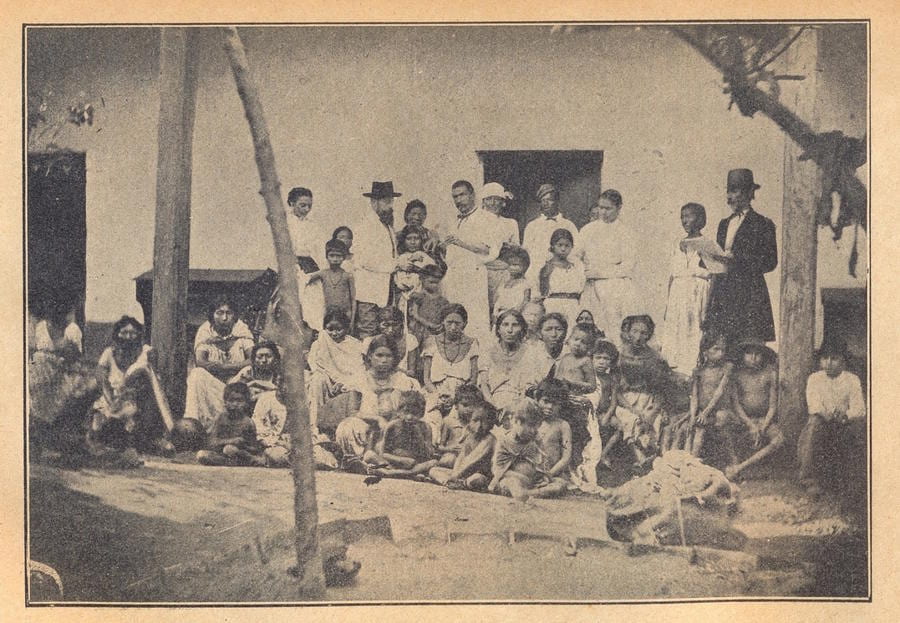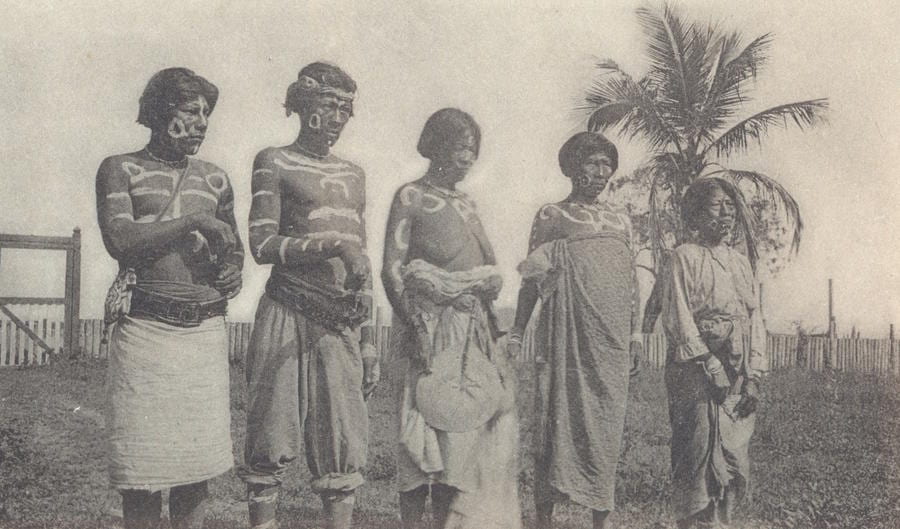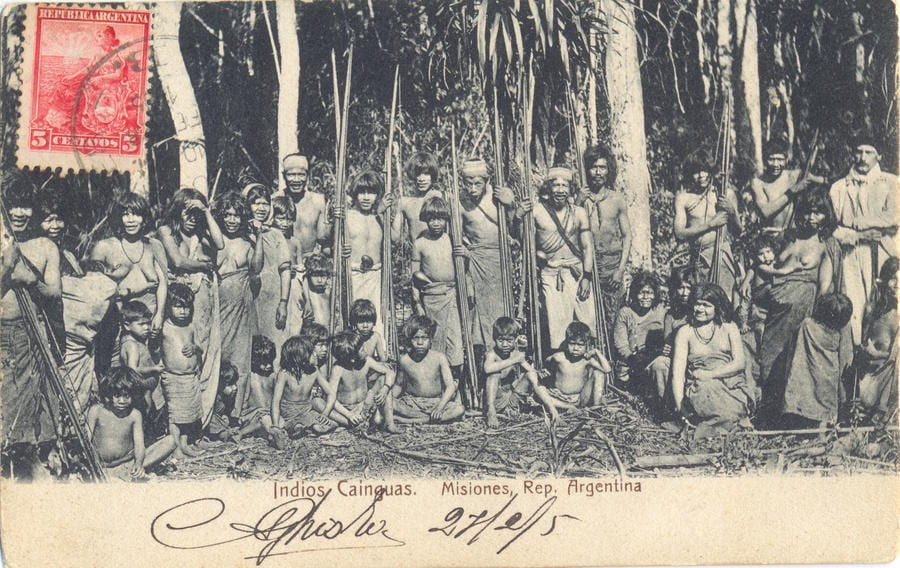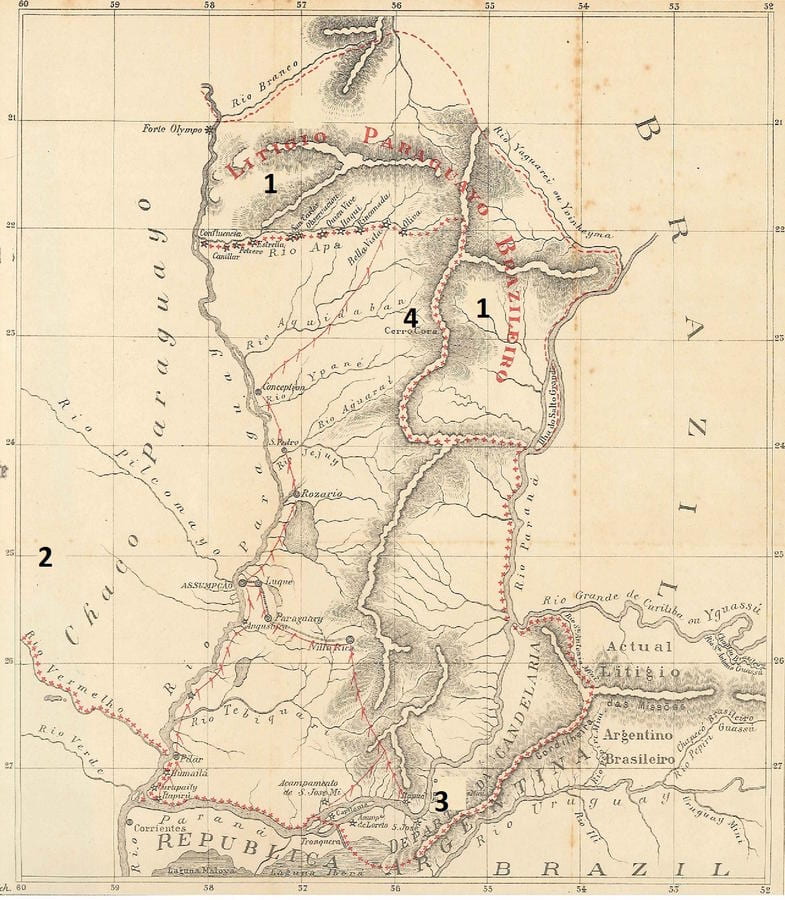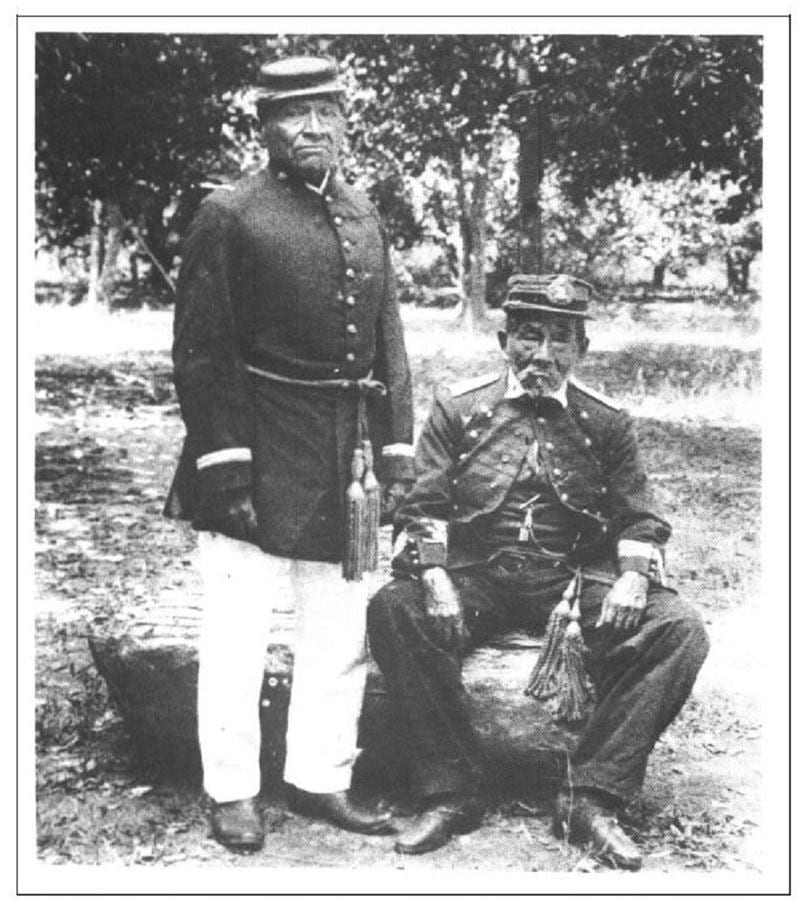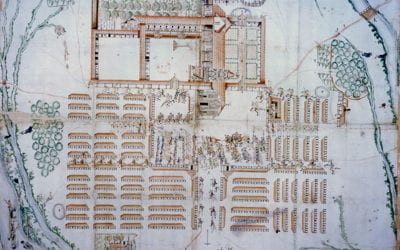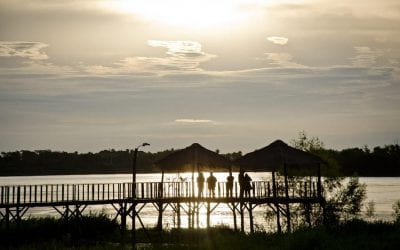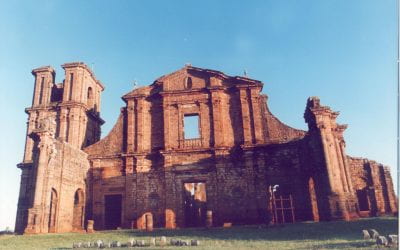Total War in Indigenous Territories
The Impact of the Great War
The War of the Triple Alliance (1865-1870) was the first total war on the American continent. Whether one uses the technical definition of German general Erich Ludendorff that involves a complete subordination of politics to war, leaving Paraguay with only two alternatives, victory or utter defeat, or if one uses the more ample definition of a total war as affecting the whole of society, economy and territory of a country, this war, also known as the Great War, engulfed the region.
Although it started and ended in indigenous ancestral territories, and directly or indirectly concerned a dozen pre-Columbian nations, studies on the Great War have forgotten these protagonists. Without taking any military initiative, the indigenous peoples ended up being the biggest losers of the tragic campaign.
This war pitted small Paraguay against the two South American powers—the former Brazilian Empire and the Argentine Confederation—and another small country, Uruguay. On December 1864, Paraguayan forces attacked Mato Grosso (1 on map, p. 64), with its small Brazilian towns (Corumbá, Miranda, Albuquerque) surrounded by Indian villages Kadiweu-Guaycurú, Xané-Guaná and Guato.
The war ended five years later in March 1870, with the defeat of Paraguay in Cerro Corá, state of Amambay, a wild region with hundreds of Guarani villages from the Mbyá Guarani, Avá Guarani and Paï Tavyterá tribes (4 on map). Unlike Mato Grosso Indians—who had casual encounters with the Portuguese—these Guarani had no contact with Paraguayan society except for clashes with yerba mate (Ilex Paraguayensis) harvesters, who had ventured into the region since the early 19th century.
Two other disputed areas, where there had been small battles, were also populated by natives. Large Nivaklé and Toba groups were living in the lower Chaco (2 on the map), from the banks of the Pilcomayo to the Bermejo River. The area did not experience Spanish (criollo) occupation until 1870. Guarani villages had also been settled in Candelaria on the left bank of the Paraná (3 on map) since the times of the Jesuit Missions.
After the war, both of these areas were left under Argentine rule. Even before the Paraguayans started selling public lands (1885-1890), the government of Buenos Aires sold land for the benefit of large producers of sugar, tannin essence and yerba mate.
INDIAN ALLIES? PARAGUAYAN INDIANS?
In anachronistic readings, nationalistic writers boasted about how “their natives” identified with the “national cause.” However, the few military memoirs mentioning indigenous people provide a different account. Indeed, given that the emerging nation-states from the Rio de la Plata would be consolidated only after—and in part thanks to—this international conflict, it seems unlikely that the various indigenous communities, harassed like animals or in a fragile truce with local authorities, could feel any kind of patriotism.
On the Paraguayan side, the matter was even more complicated because of the Allied propaganda campaign, which described the enemy—Paraguay—in newspaper articles and campaign reports as “wild,” “Indian raiders,” or as an “Indian camp” army. More scholarly accounts explained the “blind submission” of the troops to Marshal Francisco Solano López as a consequence of the Guarani servitude in the Jesuit Missions.
Offsetting these allegations, Paraguay didn’t claim that indigenous people provided military support. However, some memoirs—such as those of Frenchwoman Dorotea Duprat de Lasserre, Brazilian Viscount Alfredo d’Escragnolle Taunay and Paraguayan geographer Hector F. Decoud—did describe contacts with the Guarani during the final stages of the war.
Uncontacted Guarani indigenous tribes living in the jungle were called Cainguá—without further distinction—by the Paraguayans. López established confinement camps for women such as Panadero (in what is now Canindeyú state) or Espadín in Mbya and Avá-Guarani territory. The Cainguá approached these camps to barter food with these starving women for clothes, jewelry and utensils. They also guided those who managed to escape from these camps to the Brazilian encampments.
At the same time, in exchange for substantial gifts, some individuals served the retreating Paraguayan army as skillful local guides (baqueanos) and spies (pomberos) in jungle trails that led to areas occupied by the Allies. During the last part of the journey (that took place in the forests and hills of what is now Amambay state), the Paraguayan army had to employ Paï Tavyterá guides from another large Guarani tribe also known as Kaiowá in the Brazilian Mato Grosso.
Some Indians from the Chaco region—such as the Guaycurú (Qom), traditional owners of the Paraguay River—had been providing services to the Paraguayan government since the times of the dictator José Gaspar Rodríguez de Francia, who ruled the country from 1814-1840. In their fast canoes, they also served as postmen between the fortress of Humaitá and Asunción in the early years of the conflict.
The role of indigenous people has been better documented in Brazil. Since the 18th century, the Mbayá-Guaycurú (Caduveo or Kadiweu) and the Chané-Guaná (Terena, Guaná) from southern Mato Grosso fought against the Portuguese occupants of the Pantanal. But after a hard initial resistance, the Guaycurú agreed to a peace treaty with them at the end of the colonial times.
Their attacks on Paraguayan criollos and Guarani Indians had no truce, however. Warlords and aggressive horsemen, they attacked Paraguayan villages regularly, stealing cattle and capturing slaves. The toponymy of the north (Apa, Aquidabán, Agaguigó) recalls its ancestral sovereignty. Hostility worsened with increased persecution by dictator Rodriguez de Francia and with the support of Brazilians who gave them guns and bought their loot such as cattles and horses.
Some Guaycurú Indians, known as “Captain Lapagate’s men,” carried out a weak resistance to the 1864 Paraguayan invasion of Coimbra. Together with Brazilian villagers and slaves, a Guaná group from the Mission of Bom Conselho was captured and taken to Paraguay, where few survived the end of the war. This tribe also began ambushing and attacking Paraguayan convoys, stealing horses, weapons and food.
The Guaná and Guaycurú harassed the new invader: in two clashes of 1865, the Terena took eleven Paraguayan lives and kept their cattle. That same year, an armed group of Kadiweo-Guaycurú commanded by a Brazilian officer plundered San Salvador, taking weapons, ammunition and women. The plunder was not—as noted by military chroniclers—the smallest of incentives for indigenous warlike fervor.
The group also led the displaced inhabitants of Miranda, Coimbra and Albuquerque to the hill ranges, helping them until the Imperial army could retake the area. The Kadiweo-Guaycurú and their Brazilian officer acted as expert guides and advance squads to the Brazilian military in a sparsely mapped area; their watchmen reported on Paraguayan troop movements and performed the toughest tasks such as digging trenches and graves, opening footpaths and loading war materials.
At the end of the war, the Kadiweo—equipped with modern weapons provided by the Empire—even protected the area of Rio Blanco (south of Coimbra) and Villa de Miranda, and were responsible for overseeing the banks of Alto Paraguay, amid fears that the remainder of the Paraguayan army could cross to the Mato Grosso.
THE DISASTERS OF WAR
Indigenous peoples suffered many casualties during the war, but there were also tangential longer-term casualties. Smallpox swept the Brazilian troops in Mato Grosso, and soon there was a massive outbreak amongst their allies Terena and Guaycurú, who were physiologically more vulnerable to the disease. These communities experienced higher mortality, especially because frightened indigenous soldiers abandoned the battlefront, and carried the epidemic to their villages.
Two years after the end of the war, Brazilian reports mention the “remains” of the great Guaycurú nation on the left bank of the upper Paraguay River, the Chamacoco on the opposite bank, and a few Guato survivors on the banks of the San Lorenzo river. And only “remains” are mentioned because these “nations were cruelly decimated by the smallpox epidemic.”
The Paraguayan War was a watershed for the Mato Grosso indigenous people. Brazilian criollos, led by former combatants of that same war, later colonized their vast territory. The ancestral territories Mbayá-Guaycurú and the Chané-Guaná were sold off, and these former nomads were forced to settle into indentured servitude (cativerio) on cattle ranches and rubber or yerba mate plantations, as well as railroad building.
An old Terena leader said ironically that indigenous people were rewarded for defending the borders of Brazil with “Tres botines, duas no pé e uma na bunda” (Three boots, two for the feet, and one in the butt [Eremites de Oliveira & Marques Pereira, 2007]).
In Paraguay, the war continued the expropriations begun by President López two decades earlier. At that time, he had issued a decree confiscating all the lands and communal cattle from 21 indigenous—mainly Guarani—villages. The uncontacted Cainguá, Guarani Indians living in the forests also suffered the permanent loss of their territories. From 1885 on, post-war governments did their cruel “civilizing” work, selling off that vast territory to the Industrial Paraguaya, Mate Larangeira and other yerba mate or livestock companies.
It wasn’t until a century later that the Paraguayan state would create an office to take care of indigenous affairs (INDI), securing small plots of land to Mbyá, Paï Tavyterá and Avá Guarani communities, negligible portions within their huge ancestral territory. On the outskirts of the place where the war ended (Yasuka Venda, 80 kilometers away from Cerro Corá) the Sacred Site of the Paï Tavyterá stands today. According to the Guarani cosmology, it was on that hill where the Father Creator Ñanderuvusú, in ancient times, gave rise to the world, now lost to them.
Guerra total en territorios indígenas
Por Milda Rivarola
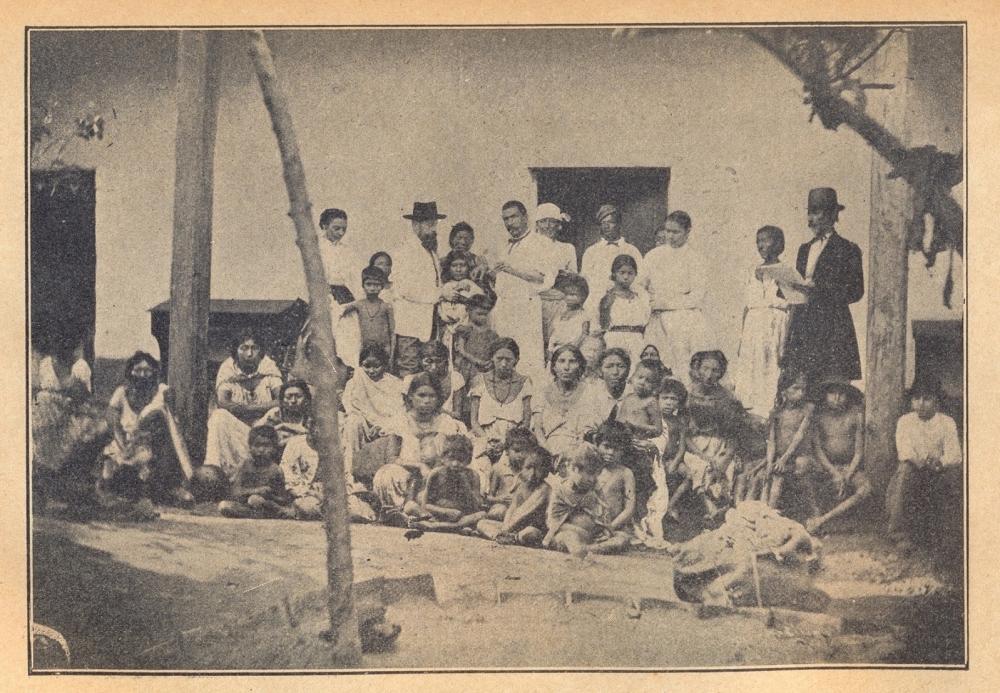
Prisioneros paraguayos (mujeres y niños). Foto cortesía de Milda Rivarola.
Fue esa la primera guerra total en suelo americano, tanto en el sentido técnico de E. Ludendorff –una completa subordinación de la política a la guerra, en el caso paraguayo, con dos únicas alternativas, victoria o total derrota- como en el otro, de haber afectado toda la sociedad, la economía y el territorio de una nación.
Aunque se inició y culminó en territorios ancestrales indígenas, y concernió directa o indirectamente a una decena de naciones pre-colombinas, los estudios sobre la Guerra de la Triple Alianza (1864/1870) olvidaron a estos protagonistas. Sin haber tomado iniciativa bélica alguna, los “indios” terminaron como grandes perdedores de la terrible contienda.
La llamada Guerra Grande enfrentó el pequeño Paraguay a dos potencias sudamericanas -el entonces Imperio del Brasil y la Confederación Argentina- y a otro pequeño país, el Uruguay. Empezó en diciembre de 1864, con el ataque de fuerzas paraguayas al Mato Grosso (1, en el mapa), donde había pequeñas ciudades brasileñas (Corumbá, Miranda, Albuquerque) rodeadas de poblados Kadiweu-Guaycurú, Xané-Guaná y Guato.
Y culminó en marzo de 1870 con la derrota del Paraguay en Cerro Corá, Amambay, una región selvática con centenares de aldeas Guaraní de los grupos Mbyá, Avá Guaraní y PaÏ Tavyterá (4, en el mapa). A diferencia de los pueblos matogrosenses, de esporádicas relaciones con los portugueses, estos no habían tenido contacto con la sociedad paraguaya, salvo choques con cosechadores de yerba mate (Ilex Paraguayensis) que se aventuraban allí desde inicios del siglo XIX.
Otras dos zonas en disputa, en las que apenas hubo batallas, también estaban pobladas por nativos. En la del bajo Chaco (2, en el mapa), de la ribera del Pilcomayo hasta la del río Bermejo, vivían extensos grupos Nivaklé y Toba, y hasta 1870 la zona no había sufrido ocupación criolla. Y en la ribera izquierda del Paraná, la Candelaria (3, en el mapa), estaban asentados pueblos Guaraní desde el tiempo de las Misiones Jesuíticas.
Tras la contienda, estas dos últimas zonas quedaron bajo soberanía argentina, y ya antes del proceso de venta de tierras públicas por el Paraguay (1880-1890) fueron privatizadas por el gobierno de Buenos Aires en beneficio de grandes industrias de azúcar, esencia de tanino y yerba mate.
¿ INDIOS ALIADOS, INDIOS PARAGUAYOS?
En lectura anacrónica, escritores nacionalistas se preciaron de ver a “sus nativos” identificados con la “causa nacional”. Pero las escasas memorias bélicas que los citan dan otra visión. Como los incipientes Estados-naciones del Plata se consolidarían sólo después de -y en cierto modo, gracias a- esa guerra internacional; mal podrían los distintos pueblos indígenas, perseguidos como salvajes o en frágiles treguas con autoridades locales, sentir alguna forma de patriotismo.
En el caso paraguayo la cuestión se complicaba debido a la campaña propagandística Aliada, que presentaba al ejército enemigo –en artículos de prensa, partes de campaña, etc.- como “salvajes”, “malones de indios”, “toldería”. Notas más eruditas explicaban la “ciega sumisión” de la tropa al Mcal. F.S. López como herencia del servilismo guaraní en las Misiones jesuíticas.
Contrarrestando ese discurso, el Paraguay no reivindicaba a los indígenas como apoyos bélicos. Algunas memorias –las de la francesa Duprat de Lasserre, del Vizconde brasileño Taunay, del paraguayo Hector F. Decoud- registran sin embargo contactos con los Guarani en la última fase de la guerra.
Los paraguayos denominaban indistintamente Cainguá a todos los Guaraní selváticos, sin contacto con el mundo criollo. Los campos de confinamiento de mujeres castigadas por el Mcal. López, como Panadero (actual Dpto. de Canindeyú) o Espadín, estaban en territorio Mbya y Avá-Guaraní. Estos Cainguá se acercaban a hacer trueque de alimentos por ropas, joyas y utensilios con estas famélicas mujeres, y a guiar a quienes escapaban de estos campos hacia los acantonamientos brasileños.
Y al mismo tiempo, mediando cuantiosos regalos, otros servían de guías (“vaqueanos”) y de espías (“pomberos”) al resto del ejército paraguayo en retirada, en senderos selváticos que los llevaban a zonas ocupadas por los Aliados. En la última parte del trayecto (selvas y cerros del actual Departamento de Amambay), el ejército paraguayo debió emplear guías Pai Tavytera, otra gran familia Guarani llamada Kaiowá en el Mato Grosso brasileño.
Algunos indios, chaqueños estos, prestaban servicio al gobierno paraguayo desde tiempo del dictador Francia: el de los Guaycurú (Qom), ancestrales dueños del río Paraguay. En sus rápidas canoas, también sirvieron de correos entre la fortaleza de Humaitá y Asunción, en los primeros años de la contienda.
El rol de los indígenas está mejor documentado en el caso brasileño. Desde el siglo XVIII, los Mbayá-Guaycurú (Caduveo o Kadiweu) y los Chané-Guaná (Terena, Guaná) del Mato Grosso del sur hicieron la guerra a los portugueses que ocupaban el Pantanal. Pero tras la dura resistencia inicial, los Guaycurú concluyeron con ellos un Tratado de paz, a fines de la colonia.
Pero sus ataques a criollos paraguayos y a indios Guaraní no tuvieron tregua. Señores de la guerra y temibles jinetes, guerreaban regularmente contra los poblados del Paraguay, arreando ganado y haciendo esclavos. La misma toponimia del norte (Apa, Aquidabán, Agaguigó) recuerda su ancestral soberanía (Ma. Fátima Costa, 2006). La enemistad se agravó con la persecución que les hizo el dictador Rodríguez de Francia, y por el apoyo de brasileños que les daban armas de fuego y compraban su botín (ganado, caballada, etc.).
La débil resistencia a la invasión paraguaya de 1864 a Coimbra se hizo con indios Guaycurú –los hombres del “capitán Lapagate”. Un grupo de Guana, de la Misión del Bom Conselho, había sido llevado prisionero –junto a pobladores brasileños y esclavos- al Paraguay, donde pocos sobrevivieron al final de la guerra. También este pueblo empezó a emboscar tropas y atacar caravanas paraguayas, a quienes robaban caballos, armas y alimentos.
Los Guaná y Guaikurú hostilizaron al nuevo invasor: en dos refriegas de 1865, los Terena causaron once bajas a los paraguayos y quedaron con su ganado. Ese mismo año un grupo armado de Kadiwéo-Guaycurú, comandando por un oficial brasileño, saqueó San Salvador llevándo armas, municiones y mujeres. El saqueo no era -como lo notan cronistas militares- el menor de los alicientes para el fervor bélico indígena.
Además guiaron a los pobladores fugitivos de Miranda, Coimbra y Albuquerque hasta las sierras, ayudándolos hasta que la zona fue retomada por el ejército imperial. Hicieron de guías y de patrullas de avanzada a los militares brasileños en una zona poco cartografiada, sus vigías informaban del movimiento de tropas paraguayas, y hacían las tareas más duras (cavado de trincheras y tumbas, apertura de picadas, carga de materiales de guerra, etc.).
Al final de la guerra, los Kadiweo –provistos de modernas armas por el Imperio – protegieron incluso la zona del río Blanco (al sur de Coimbra) y Villa de Miranda, y fueron encargados de vigilar la ribera del Alto Paraguay, ante el temor que el resto del ejército paraguayo pasara al Mato Grosso.
LOS DESASTRES DE LA GUERRA
Algunos efectos sobre los indígenas fueron sentidos durante la misma contienda, y otros, de carácter definitivo, pocos años después. La viruela atacó a las tropas brasileñas en el Mato Grosso, y pronto se dio contagio masivo entre sus aliados Terena y Guaycurú, fisiológicamente indefensos ante ella. La mortandad –sumada a las bajas normales de combates- fue por ende mucho más alta en estas comunidades, y quienes aterrorizados escapaban de las filas, trasladaban la epidemia a sus aldeas.
Dos años después del fin de la guerra, informes brasileños hablan de “restos” de la gran nación Guaycurú en la margen izquierda del alto Paraguay, de la Chamacoco en la margen opuesta, y de pocos sobrevivientes Guato en la ribera de San Lorenzo. Y dicen restos “porque ambas naciones fueron cruelmente diezmadas por la epidemia de viruela”.
En la memoria de los indígenas mato grossenses, la Guerra del Paraguay es una divisoria de aguas. Su extenso territorio fue después colonizado por criollos brasileños, en una avanzada constituida por los ex combatientes de esa misma guerra. Los ancestrales territorios Mbayá-Guaycurú y Chané-Guaná se privatizaron, y estos pueblos itinerantes fueron aldeanizados y sometidos al trabajo semi-servil (“cativerio” o enganche por deuda) en las estancias ganadera, apertura de líneas ferroviarias o cosecha de caucho o yerba mate.
En la irónica expresión de un viejo líder Terena, por defender las fronteras del Brasil ellos recibieron en premio “Tres botines, duas no pé e uma na bunda” (Tres botas, dos para los pies, y la tercera, en el trasero) (Eremites de Oliveira & Marques Pereira, 2007)
En el Paraguay, la guerra continuó la obra del presidente Don Carlos A. López, quien dos décadas antes abía desapropiado por decreto a los 21 Pueblos de Indios –Guaraní en su casi totalidad- de todas sus tierras y ganados comunitarios. Los Cainguá, Guaraní selváticos sin mayores contactos hasta entonces, también sufrieron la pérdida definitiva de sus territorios. Los gobiernos de pos-guerra hicieron su cruel tarea “civilizadora”, al privatizar desde 1885 ese extenso territorio a favor de la Industrial Paraguaya, la Mate Larangeira y otras empresas extractoras de yerba mate y productoras de ganado.
Recién un siglo más tarde el Estado paraguayo crearía una oficina indigenista (INDI) asegurando pequeñas fracciones de tierra a aldeas Mbyá, Paï Tavyterá y Avá Guaraní, dentro de su extensísimo y perdido territorio. En las cercanías del lugar donde culminó la guerra (Yasuka Venda, a unos 80 km. De Cerro Corá) se levanta hoy el Sitio Sagrado de los Pai Tavyterá. Según la cosmogonía Guaraní, fue en ese cerro donde el Padre Creador Ñanderuvusú, en tiempos inmemoriales, había dado origen al mundo, ahora perdido para ellos.
Spring 2015, Volume XIV, Number 3
Milda Rivarola is a Paraguayan historian and political analyst. She is the author of several books, including Obreros, Utopías & Revoluciones, La Contestación al Orden Liberal, La Polémica Francesa sobre la Guerra Grande and Vagos, Pobres y Soldados.
Milda Rivarola es historiadora paraguaya y analista político. Es autora de varios libros, incluyendo Obreros, Utopías & Revoluciones, La Contestación al Orden Liberal, La Polémica Francesa sobre la Guerra Grande y Vagos, Pobres y Soldados.
Related Articles
Jesuit Reflections on their Overseas Missions
When you think of Jesuits in their missions around the world, you—the casual reader—might not think of Plato or ancient Greek authors. Yet two of these…
Paraguay: Un país en una lengua misteriosa y singular
English + Español
If you arrived in a country where almost 90% of the inhabitants speak Guarani, an official and national language along with Spanish but do not identify themselves as “Indian” or aboriginal…
Territory Guarani: Editor’s Letter
DRCLAS receptions are bustling affairs, sparkling with ample liquor, Latin American tidbits and compelling conversations. It was at one of these receptions that Jorge Silvetti and Graciela Silvestri first approached me casually regarding an issue about the Guarani…

